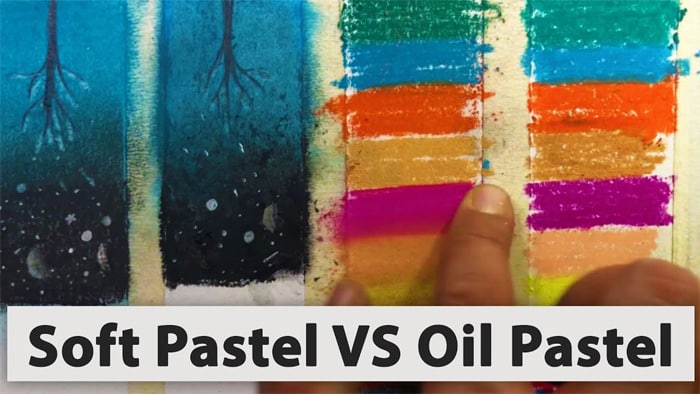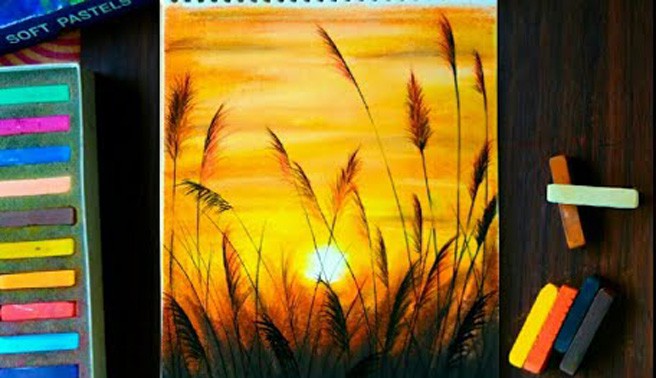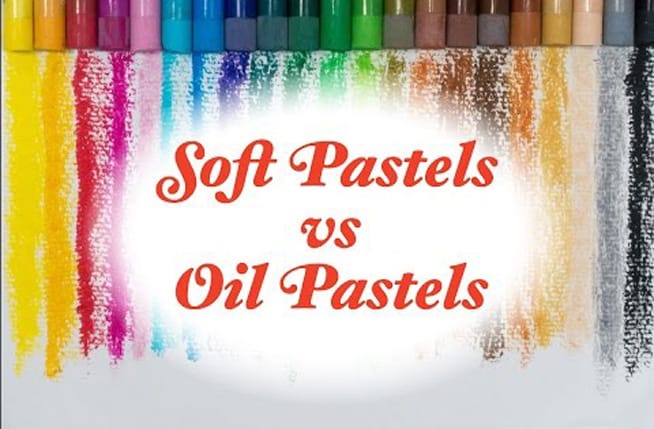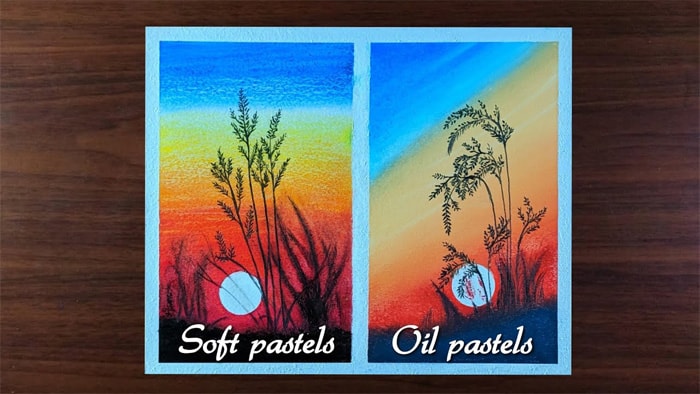Making beautiful landscape pieces with pastels has got to be one of the most exciting forms of drawing. After all, when the vivid colors latch gracefully onto the textured paper, the true beauty of oil pastels begins to show!
Not to mention, their unparalleled richness of color and blending quality beat hard pastels any time!
If you’re interested in soft pastels vs. oil pastels and knowing what’s the difference between them, this is a good place to start. Here we’ll be discussing the perks of these two similar yet distinct mediums and the qualities that set them apart!
Although one thing is for sure, you have plenty of room to be versatile with good-quality pastel sticks. Like William Chase, the renowned American portraitist, artists can quickly grasp the ways of this brilliant medium and reinvent its techniques. Let’s get started!
The Difference Between Soft Pastels and Oil Pastels

There are many forms of colors, some of which will fascinate you greatly. If you ask us, making pastel artworks was something we picked up from early childhood.
Not to mention, the compelling urban landscapes by Childe Hassam made us put our heart and soul in pastel painting in the first place! There are also many types of pastel colors available for us. Like-
- Soft pastels
- Hard pastels
- Pan pastels
- Pastel pencils
- Oil pastels
Composition & Texture
All pastel colors are made by combining chalk and dry pigment. Then a binder is used to form a paste. Later on, this paste is poured into a mold and hardened. And this is how your favorite pastel sticks are made!
However, there are differences among all types of production of pastel colors. For example, soft pastels have less binder in their composition- allowing you to procure rich, velvety hues on a boring canvas.
Oil pastels, on the other hand, have a non-drying oil and waxy binder mixture. Its composition varies from that of soft pastels in terms of the binder material. See, soft pastels incorporate methylcellulose or a gum binder, whereas oil pastels use wax binders.
Consequently, oil pastels leave a luminous finish and have a pretty good archive life for their non-drying oils. Although, using spray fixatives on both mediums is a smart way to conclude pastel-painting.
Here you will get ideas about soft pastels and oil pastels if you are wondering which one is the best for you to use!
Soft Pastels

Many people think soft pastels are beginner tools compared to paintbrushes. But it’s not entirely true. Soft pastels are evenly pigmented, rich in color, and they blend seamlessly into your previous strokes.
In our beginner days, we drew inspiration from the mesmerizing pastel portraits made by Mary Cassatt with her bold strokes. Let’s get to know more about her favorite medium!
What Are Soft Pastels Made of?
White chalk, gum Arabic, and pigment are used to make soft pastels. These elements give them a dry, matte finish. Moreover, they do not stick firmly to the surfaces or papers, and for that reason, they can easily be brushed off.
What Qualities Do Soft Pastels Have?
- Soft pastels are available in a wide range of colors and different shades
- Fragile consistency
- Powdery texture
- Can be washed off by water
- Have beautiful color intensity
- They may also easily crumble
What Are the Soft Pastels Used for?
Since soft pastels have light consistency, they are suitable for preliminary sketches. Modern artists like soft pastels as a complementary medium used in complex landscape pieces.
On top of that, their powdery texture allows them to be well-suited for blending and layering. You can use the edges of soft pastels to draw the borderlines. You can cover vast areas by using these pastels and create multiple effects by blending different shades.
What Paper Should Be Used for Soft Pastels?
Textured papers are the best for soft pastel colors. But there is a specific type of paper called Ingres paper, which is the best one to apply pastel color on. In fact, there are many colors and shapes of these papers that you can get your hands on.
Oil Pastels

Did you know that the famous artwork, Starry Night by Vincent Van Gogh, is actually an oil painting?
This painting of a moonlit nightscape might prompt you to try first-hand oil painting right away.
But if you really wish to achieve such depths of color, practicing with oil pastels is a great decision.
The freshness and sheen of oil pastels sometimes exceed those of oil paints altogether, only when you know how to keep the canvas clean!
What Are Oil Pastels Made of?
Oil pastels are another popular kind of pastel. The oil pastels are made by using pigments and bound with oil. Unlike soft pastels, no synthetic gum is used in the making of oil pastels.
It’s just the common linseed oil. This is the main thing that makes the difference between soft and oil pastels.
What Qualities Do Oil Pastels Have?
- They are basically of the sturdy type
- Usually, they come in stick shapes and square edges
- They have a wax-like texture
- Also have a creamy consistency
- They never dry out like oil paints
What Are Oil Pastels Used for?
The oil pastels are much easier to carry, and their creamy texture makes them useful for sketches and sustained works. You can also use oil pastels with a combination of soft pastels. Moreover, you can also sharpen them when necessary.
On top of that, oil pastels have an intense hue, and they produce an outstanding painting experience.
What Paper Should Be Used for Oil Pastels?
Oil pastels are not like regular colors that can be effective on regular papers. You will need paper that is versatile, thick, and bleed-proof. Pastel paper and canvas pair beautifully with oil pastels. You will need a ton of these if you’re into Jean Millet paintings!
What Can I Paint with Pastel Sticks?
To explore the inner artist in you, we recommend starting out with soft pastels before oil pastels. It’s because soft pastels give you the opportunity to try different blends and shades with possibilities of distinct strokes.
On the other hand, oil pastels have a buttery feel to them- giving you a smooth experience similar to that with oil paints.
Now, this medium is the easiest to use compared to hard pastels and even soft pastels! Anything between impasto effects and glossy abstracts is possible with your favorite set of oil pastels. What can we say? Maybe you’ll be the next Edgar Degas, a life-long pastelist who gave painting with pastels a new name!
With the right strokes of oil pastel, you can portray luscious summer gardens and night skies. Similarly, soft pastels give you that much-desired finish and make your artwork stand out against the canvas.
Similarities Between Soft Pastels and Oil Pastels

Both soft and oil pastels are amazing to use for artists. If you have tried them both, you’ll know what a pleasure these pastels are to work with! That being said, painting breath-taking abstract artworks with pastel sticks is only a matter of time!
To put things into perspective, you can create both detailed and smooth blending with soft pastels. If you like light-colored paintings, soft pastels would be great for you.
On the other hand, if you like mixing colors and adore dark textured paintings, oil pastels would be the best option for you.
So, you can go for either of them depending on what type of paint you prefer and how much experience you have. But using oil paintings as a beginner might not be suitable.
Moving on, you can use soft pastels during your starting period. Then you can gather some enjoyable experiences with oil pastels. But one thing is certain- you will have fun to the fullest while painting with either of them if you are an art lover.
Final Words
Be it soft pastels or oil pastels; there’s no denying that pastel artworks are some of the most fascinating ones out there. From layering your first few strokes to smudging the outlines for a dramatic effect, the journey of mastering pastels is a rewarding one.
It’s also full of surprises if you let your creativity loose on the canvas. This was our take on soft pastels vs. oil pastels, and differences in between.
Personally, we enjoy painting velvety landscapes and dabble in portraits. Going freestyle and using a combination of soft and hard pastels is also our thing!

